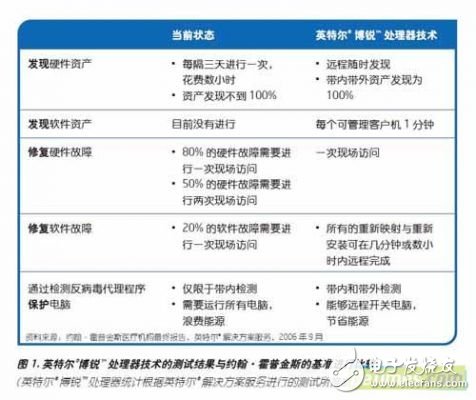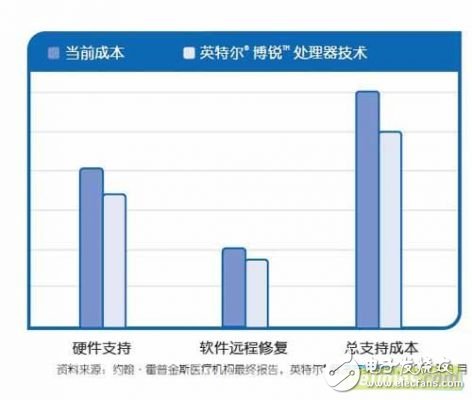Improve remote management of more than 9,000 desktops for patient care, laboratory work, medical research and management at 25 sites in Maryland to simplify computer diagnostics and repairs to reduce the time and cost of on-site visits while improving Computer uptime for doctors, researchers, and staff improves the accuracy of asset inventory and patch management across the network.
solutionJohns Hopkins IT and Intel Solution Services work together to evaluate the remote computer management capabilities of Intel vPro processor technology for computer diagnostics and repair, asset management and security
AdvantageTest results show that in four years, Intel vPro processor technology can help Johns Hopkins save an average of 20% of software support costs and 17% of hardware support costs per year, while generating a 32% return on investment.
Johns Hopkins can greatly reduce the time it takes to diagnose and repair computer problems, helping doctors and staff maintain high productivity, improved asset inventory and remote patch deployment capabilities, helping to ensure that all computers receive software deployment and Stay away from threats
Computer startup and shutdown capabilities can significantly save energy
Because Intel vPro processor technology can provide technicians with accurate hardware asset inventory, remote hardware problems can be identified even before the initial on-site visit. At the same time, Intel vPro processor technology can eliminate the second on-site visit that is typically required to resolve hardware failures. Tests have shown that remote diagnostics can reduce the total repair time per failure by 10 minutes.
Intel vPro processor technology and Intel Active Management Technology also help the Johns Hopkins Hospital DCS (Desktop Computing Services) team improve system asset discovery and inventory of their widely distributed computers to ensure complete patch deployment . DCS can use the target TCP/IP scan to discover and inventory the systems on the network, which can accurately inventory all systems on the network that support Intel vPro technology. Out-of-band (OOB) capabilities provided by Intel Active Management Technology support DCS collection
A definite inventory, even if the computer is turned off. The OOB feature also helps ensure a complete deployment of software patches. DCS administrators can check for viruses and management agent versions on manageable clients, even if the system is down. In addition, OOB capabilities also enable administrators to turn on the system and use third-party tools to discover software assets on the computer.
Intel consultants conducted a cost analysis and found that the Johns Hopkins DCS team saved an average of 20% in software support costs and 17% in hardware support costs per year for four years, while delivering a 32% potential return on investment. In addition, after performing maintenance tasks, the shutdown capability can save Johns Hopkins 1/3 to 1/2 of the computer's power consumption. “The cost savings advantage is not limited to our IT department,†Romero said. “Johns Hopkins can invest more in management and power consumption in clinical care, research, and education.â€
Intel vPro processor technology helps Johns Hopkins users focus on creative work
Romero said: "We expect Intel vPro processor technology to allow us to respond quickly to problems and improve productivity while performing regular management and maintenance. Therefore, we can get more resources to seek a new solution. The plan is to calmly meet various challenges."
Finally, the use of Intel vPro processor technology will also help the DCS team refocus on the innovative project of John Hopkins' corporate culture. Sears said: “Doctors and researchers continue to ask us for value-added services. The more we can eliminate computer failures and make IT work, the better we can provide them with next-generation services. Our job is to help Researchers and clinicians focus on creative work. Intel vPro processor technology helps us spend less time and money on keeping our computers up and running, so we focus more on providing our users with Need support."
Technology is key to the outstanding achievements of Johns Hopkins University and Johns Hopkins Hospital in education, patient care and research. Every job of doctors, staff, students, and administrators relies to a large extent on Johns Hopkins' 30,000 computers, including the processing of clinical orders, the use of electronic medical records, and the completion of Classroom assignments, scientific research, and schedules. Although John Hopkins' IT department is able to maintain the normal operation of many computers and protect them through remote management software and on-site visits, employees are eager to develop strategies to help them reduce the support burden so that they will be more More time devoted to the research of innovative projects.
The Johns Hopkins Desktop Computing Services (DCS) team is a division of its IT department that provides support for 9,000 computers at Johns Hopkins Hospital, which are distributed throughout pediatric and surgical, remote sites. Other laboratories, outpatient departments, and administrative areas. It also includes public workstations in the clinic and private workstations for administrative and research staff. Robert Romero, senior director of IT at Johns Hopkins, said: "Supporting a large number of hospital and university users and a small number of IT administrators is a serious challenge. Our DCS team needs to manage a large number of configurations and platforms."
However, providing such support is critical to the success of the entire department. Steve Sears, head of the Johns Hopkins DCS group, said: "We use computers to do everything, including scheduling, billing, fetal monitoring, and diagnostics. Keep these computers up and running. The operation of our medical system is critical."
Formal assessmentThe DES team needs an efficient way to speed up the diagnosis and repair of hardware and software failures. To ensure that doctors and staff downtime is minimized, DCS teams often have to make on-site visits, even for software-related issues. Sears said: "Our goal is to reduce the time technicians spend in the clinical area. These are very busy areas, we don't want to hinder. Whether we need to remap the operating system, or swap the failed hard drive, usually, we are the first Replace the computer and then analyze the failure. We need to ensure that doctors and staff can maintain efficient work."
While replacing a computer can minimize end-user downtime, on-site visits are time consuming and costly for the DES team. For remote sites, on-site visits will take up to 75 minutes. Despite the high annual software maintenance costs, hardware maintenance costs are higher, mainly because hardware failures need to be resolved more frequently through on-site visits.
The DCS team also needs a way to improve platform discovery to ensure that maintenance costs are in compliance with appropriate regulations and paid correctly. Sears said: “Every three days, we send technicians to inventory hardware assets. But this requires a lot of time that we could have used to study other projects. Our platform found that the accuracy rate is less than 100%. I need to turn on the computer to help us get the right inventory, but that's not always the case."
Finding a way to efficiently control the power state of your computer can not only help with asset inventory, but it also helps with patch management. Sears said: "If someone takes the computer away from the designated area, or shuts it down, we can't guarantee the complete deployment of the new patch. This is the biggest problem that causes software distribution failure: we can't monitor these computers all the time. Usually, we ask Users are guaranteed to turn on the computer 24/7 so that we can deploy patches at night, but this wastes energy. We are very interested in finding a way to boot and shut down remotely so that we can work and then turn off the computer to save energy."
provide the solutionIntel 8 Solution Services worked with Johns Hopkins' DCS team to find effective ways to improve the centralized management of distributed computer systems. After evaluating the current challenges facing the division, Intel consultants recommended Intel vPro processor technology. Intel. The vPro processor technology consists of a set of components, including processors, chipsets, networks, and other technologies, all of which together provide extensive remote management capabilities. With the help of Intel, vPro... processor technology, John Hope Kings' IT department is able to speed up diagnostics and repairs, improve the efficiency of asset inventory, and deploy patches more completely.
Intel vPro processor technology uses Intel Active Management Technology (lntel AMT) in its platform hardware. Intel Active Management Technology provides a remote communication channel that is always available to authorized IT administrators if the computer is not functioning properly. As long as the computer is plugged in and connected to the network, the administrator can access the computer. Intel. Active management technology includes permanent non-volatile memory that can store important information securely here. In addition, in addition to encrypted communications, Intel Active Management Technology uses mutual authentication between the customer and the console to help prevent unauthorized access to the network and computers. Compared to Wake-on-LAN tools, Intel Active Management Technology has a higher level of security and functionality, so administrators can safely collect critical hardware and software asset information, even if the computer is shut down, reconfigured, or fails.

Intel Solution Services designed a test environment that uses five computers with Intel vPro technology. These computers are controlled by a server running third-party system management software, LAN management software, and diagnostic utilities. Intel consultants showed John Hopkins an effective way to help Intel vPro processor technology help them cope with the specific challenges they face.
Tests have shown that by adopting Intel vPro processor technology, Johns Hopkins DCS can greatly reduce the time to diagnose and repair software failures. System failures due to software or operating system crashes can be fixed or remapped remotely without on-site access. With a PC with Intel vPro technology, Johns Hopkins can reduce the time to fix a failure by 10%.

Figure 2 Expected potential savings due to Intel vPro processor technology
Intel vPro processor technology: Advance a variety of remote management capabilities, including asset management, diagnostics and repair, enhanced security and more.
Intel Active Management Technology (Intel AMT): Includes permanent non-volatile memory and a hardware-based communication channel that allows administrators to collect information and provide services even when the computer is turned off or the operating system is not running.
Screen Protector,Uv Glue Screen Protector,Uv Tpu Film Screen Protector,Uv Curing Screen Protector
Shenzhen TUOLI Electronic Technology Co., Ltd. , https://www.hydrogelprotectors.com